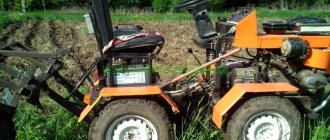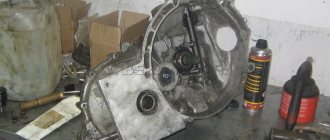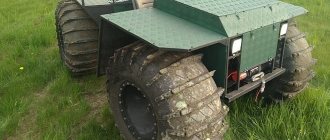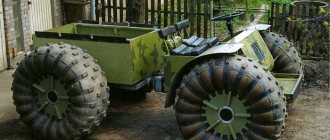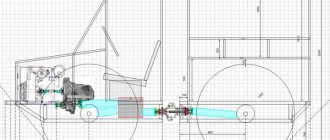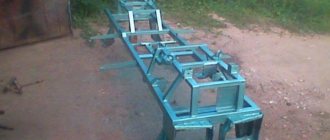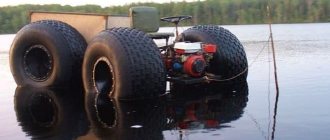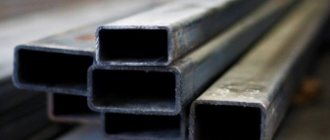The all-terrain vehicle "Bobik" is made according to the "perelomka" design, that is, it consists of two independent semi-frames that can independently rotate both in the horizontal and vertical planes. This design virtually eliminates the wheels hanging out on uneven surfaces and almost always all four wheels have contact with the ground. This increases the cross-country ability of the all-terrain vehicle, turning is carried out by turning the semi-frames, that is, the wheels themselves do not turn, they turn due to the skew of the semi-frames. Load capacity on land is about 300 kg, on water 200 kg. The curb weight of the all-terrain vehicle is 780 kg, the maximum speed is 25 km/h.
The frame is made of a profile pipe, the size of the front half-frame is length 165cm, width 80cm, height 26cm. The motor is located in front, which takes up 75 cm. For the frame, profiles with dimensions 40*40*2mm 40*20*1.5mm 40*25*2mm were used. The rear semi-frame is trapezoidal. Height 20cm, base width 81cm, side edges 90cm long, half frame height 26cm.
The outer skin is made of painted smooth sheet, which is attached to the frame with aluminum rivets. The all-terrain vehicle is small in size and capacity, the design was designed for minimally comfortable dimensions, and for an economical low-power engine, so the weight was reduced as much as possible without compromising the reliability and strength of the frame and transmission.
The base of the all-terrain vehicle is 183 cm; to attach the semi-frames, reinforced plates 10 mm thick are welded to their ends, through which the turning point is attached. The fracture unit is based on the steering knuckle of the UAZ front axle. The driver's seat (from the passenger Gazelle) is located on the rear edge of the front half-frame, one might say that it is almost in the center of gravity of the all-terrain vehicle. A full-fledged car battery is installed under the seat, the driver's seating position is high, conducive to overcoming off-road conditions and uneven terrain.
The transmission looks like this: From the engine, torque is transmitted by four belts to the gearbox. The pulley on the engine has a diameter of 9.5 cm, the pulley on the box is 26 cm, it is installed on the support shaft to relieve the load on the box shaft, and rotates in a double-row bearing from the front wheel of the VAZ-2108. A splined bushing from the VAZ clutch disc is welded to the end of the driven pulley support shaft; this bushing includes the input shaft of the VAZ-2106 gearbox. The belts are tensioned by a roller on two springs, this roller also acts as a clutch, the length of the belts is 125cm. The generator drive is taken from the drive pulley on the engine by the fifth belt; the generator belt is from the D-240 diesel engine and almost all of its modifications.
Four belts in the drive were used to extend their life. In general, it would be possible to install one belt, but it would quickly wear out. The motor power is 9 kW, and for these belts the load should be 2 kW, just enough for four belts.
The output shaft of the box is cut off at the beginning of the splines, and the splines are fitted onto the VAZ cardan flange, while the cardan pipe is cut to the required size. The second end of the cardan is screwed by the cardan flange to the shaft of the chain gearbox, on which a sprocket Z=13 is welded, pitch 19.05 mm. The gearbox is made on the basis of the VAZ front hub and is attached to a metal plate, which in turn is screwed to the frame and can be shifted to tension the chain. From the intermediate shaft, the chain drive goes to the steering knuckle, on which a 41-tooth sprocket is installed, and from the knuckle the drive is distributed by cardans to the front and rear axles.
Driver's seat and controls. The brake pedal presses the brake cylinder through the rod (a UAZ clutch cylinder is installed). The clutch pedal is driven by a cable to the tension roller of the engine drive belts; by squeezing, the roller is pulled back and the belts begin to slip. The gas pedal controls the carburetor through a cable. The steering wheel and upper crosspiece are from a VAZ2106, the lower crosspiece is from an M-2141, the crosspieces are connected using a 20*20mm profile. The rake is also from M-2141. Under the steering wheel on the right is the carburetor damper drive, and there is also a headlight switch, a horn button and a battery mass switch.
Transmission
A drive pulley with a diameter of 95 mm is installed on the output shaft of the engine (Lifan 182FD or similar). The pulley has five grooves of profile “A”. Four of them are intended for clutch drive belts and one (outmost) is for driving a generator or hydraulic pump. The shafts on different engines are not the same size and have different keyway widths, so you have to be careful here.
The length of the “A” profile belts (generator from the D-240 diesel engine) is 1250 mm. The belts are tensioned by a roller with two springs. The roller rotates in two bearings 180203. Its axis, for convenience, fits into the bearings using a “sliding” fit, that is, quite freely (by hand). When the axle nut is tightened, the inner races of the bearings are clamped between the spacers and do not rotate.
Fracture. Where does this name come from?
The breakaway all-terrain vehicle is called that way because of the peculiarities of its design. It consists of two half-frames interlocking with each other. The semi-frames are independent, which is very important. They can move as desired relative to each other horizontally, rise and fall in the vertical plane. Due to this design, the high patency of fractures is ensured, and as a result, their great popularity among the population. Such all-terrain vehicles almost never have wheels hanging out, which guarantees excellent traction.
If we continue the conversation about the design of all-terrain vehicles, we can note that, for the most part, such equipment is a piece product, therefore, each vehicle has its own equipment. Of course, the general principle of the device is the same: engine, gearbox, clutch, large wheels, usually with low-pressure tires. But each model has its own characteristics. For example, one designer installs an Oka engine on a vehicle, while the second believes that it would be more expedient to fit a Moskvich engine.
However, studying topics on forums for off-road enthusiasts, one can come to the conclusion that there are already typical examples of all-terrain vehicles that are duplicating, modifying, and creating new models based on them.
Driver's cabin
The driver's seat is located behind the engine compartment and is separated from it by a partition made of duralumin sheet on a frame made of pipes with a cross-section of 20x20 mm. The driver's cabin is semi-closed (without doors or rear wall). The seat is from a passenger Gazelle. There is a 60 Ah battery under the seat. The steering column is converted from a Zhiguli one (VAZ-2106), and the upper part of the steering propeller shaft is taken from there. Its lower part is made of a 20x20x2 mm profile pipe, the crosspiece of the steering cardan is 2141 “Moskvich”. The steering mechanism (“rack”) was also borrowed from the M-2141.
Pedal units are from Zhiguli. Their location is the same as on a car. The clutch pedal is connected to the tension roller of the clutch belt via a cable. The brakes are transmission brakes, the disc is mounted on the driven sprocket shaft. The pedal is connected by a rod to the main brake cylinder (from the UAZ clutch), which drives the brake caliper cylinders (from the VAZ-2108). The gas pedal is homemade, connected to the carburetor with a Bowden cable.
Under the steering wheel there is a panel on which there is a toggle switch for turning on the headlights, a cable handle for the carburetor air damper, a horn button and a ground switch.
The all-terrain vehicle "Bobik" has been modernized several times, and even has several similar copies, which were distributed to different owners. Therefore, some drawings may differ in some ways from the images in the photographs.
Self-made all-terrain vehicles broken, photo | video
A long time ago, in the author’s yard there was an old VAZ 32101, rotten in places. It stood for a long time and took up space, while repairing this car would have been too expensive and not practical, but
Read more
This homemade product was made by my friend. He did it for about a year. The engine assembled with the gearbox is Bulgarian, the steering column is from a VAZ 2107, the wheel rims are from Oka converted into four holes, the seats are from UAZ,
Read more
Another all-terrain vehicle with a tipping frame design and all-wheel drive. Before starting its production, the author clearly determined for himself that the all-terrain vehicle should cope perfectly with any road conditions.
Read more
The all-terrain vehicle has all-wheel drive and is built on a tipping-type frame. This all-terrain vehicle is capable of not only overcoming any terrain, but also perfectly crossing rivers and small ponds.
Read more
Initially, the author planned to make a light karkat, but after looking at the required effort and costs, he decided that creating a larger all-terrain vehicle with a tipping-type frame design would not cost much
Read more
This all-terrain vehicle was made by the author for fishing trips and berry picking. This means that in addition to excellent maneuverability on forest roads, the all-terrain vehicle also had to be able to overcome swampy
Read more
Karakat with tipping type frame design and all-wheel drive. The all-terrain vehicle was built for fishing trips, picking berries and mushrooms. The author tried to use the maximum available details for
Read more
This all-terrain vehicle is built according to a similar design scheme for the Uvat and Asterix all-terrain vehicles. The machine is based on a fracture-type frame. The all-terrain vehicle was designed to transport two people, as well as
Read more
This caracat was built for fishing and hunting trips, as well as for household needs, such as delivering firewood. The all-terrain vehicle is designed for two people, and can also carry cargo weighing up to
Read more
Since the author had already assembled a maneuverable lightweight pneumatic all-terrain vehicle, this time he decided to assemble a larger all-terrain vehicle. The author decided to use all-wheel drive and a fracture-type frame.
Read more
This all-terrain vehicle with all-wheel drive and a fracture-type frame design was manufactured in just a month and a half. The author made this all-terrain vehicle to order. The all-terrain vehicle was created for clay tracks and
Read more
The machine was initially designed in a 3D modeling editor with the basic design requirements, which are the minimum weight of the machine, the minimum turning radius, so that it is convenient
Read more
Another interesting option for an all-terrain vehicle with a tipping-type frame and all-wheel drive. The all-terrain vehicle was assembled for hunting and fishing. The author paid special attention to the quiet running of the all-terrain vehicle, so that
Read more
Quite a large version of an all-terrain vehicle with all-wheel drive on a tipping-type frame design. The author made the all-terrain vehicle quite spacious in order to accommodate the largest number of passengers. On the rear frame
Read more
This all-terrain vehicle can carry up to four passengers and cargo. The car also floats well and is able to cross rivers and ponds. During construction, the author paid special attention to weight
Read more
During the construction of this all-terrain vehicle, the author tried to arrange all the elements and parts in such a way that all components of the all-terrain vehicle were easily accessible for maintenance or replacement. And so it happened,
Read more
The all-terrain vehicle has all-wheel drive and a fracture-type frame based on the steering knuckle from the UAZ. The front axle of the all-terrain vehicle is equipped with factory-produced automatic partial locking,
Read more
An interesting caracat model with a tipping-type frame design and all-wheel drive on OI-25 tires. The weight of the all-terrain vehicle was about 450 kilograms. The all-terrain vehicle was initially designed for two people and
Read more
The all-terrain vehicle has a tipping-type frame and all-wheel drive. The all-terrain vehicle is made according to a fairly simple and standard design. When building it, the author tried to use the highest quality parts,
Read more
The all-terrain vehicle has a fracture-type frame design. The author wanted to make a large and powerful all-terrain vehicle with good carrying capacity. The author also tried for the most part to avoid additional nodes and
Read more
usamodelkina.ru
Basic data of the Bobik all-terrain vehicle
Engine - Lifan 182FD, 11 hp, four-stroke, forced air cooling, made in China. The gearbox is from a VAZ-2106, four-speed. Bridges are from VAZ-2106, gear ratio 3.9. Tires - VI-3 (from KRAZ-255B), lightweight (“torn”), actual size 1250×520-533 mm. The wheels are non-separable (for beading), with the tires secured with bolts. Overall dimensions (length x width * height) - 3300x1950x2300 mm. Loading capacity on land/water -300/200 kg. Curb weight - 780 kg. Maximum speed - 25 km/h
Karakat fracture with your own hands drawings and diagrams
The all-terrain vehicle "Bobik" is made according to the "perelomka" design, that is, it consists of two independent semi-frames that can independently rotate both in the horizontal and vertical planes. This design virtually eliminates the wheels hanging out on uneven surfaces and almost always all four wheels have contact with the ground. This increases the cross-country ability of the all-terrain vehicle, turning is carried out by turning the semi-frames, that is, the wheels themselves do not turn, they turn due to the skew of the semi-frames. Load capacity on land is about 300 kg, on water 200 kg. The curb weight of the all-terrain vehicle is 780 kg, the maximum speed is 25 km/h.
The frame is made of a profile pipe, the size of the front half-frame is length 165cm, width 80cm, height 26cm. The motor is located in front, which takes up 75 cm. For the frame, profiles with dimensions 40*40*2mm 40*20*1.5mm 40*25*2mm were used. The rear semi-frame is trapezoidal. Height 20cm, base width 81cm, side edges 90cm long, half frame height 26cm.
The outer skin is made of painted smooth sheet, which is attached to the frame with aluminum rivets. The all-terrain vehicle is small in size and capacity, the design was designed for minimally comfortable dimensions, and for an economical low-power engine, so the weight was reduced as much as possible without compromising the reliability and strength of the frame and transmission.
The base of the all-terrain vehicle is 183 cm; to attach the semi-frames, reinforced plates 10 mm thick are welded to their ends, through which the turning point is attached. The fracture unit is based on the steering knuckle of the UAZ front axle. The driver's seat (from the passenger Gazelle) is located on the rear edge of the front half-frame, one might say that it is almost in the center of gravity of the all-terrain vehicle. A full-fledged car battery is installed under the seat, the driver's seating position is high, conducive to overcoming off-road conditions and uneven terrain.
The transmission looks like this: From the engine, torque is transmitted by four belts to the gearbox. The pulley on the engine has a diameter of 9.5 cm, the pulley on the box is 26 cm, it is installed on the support shaft to relieve the load on the box shaft, and rotates in a double-row bearing from the front wheel of the VAZ-2108. A splined bushing from the VAZ clutch disc is welded to the end of the driven pulley support shaft; this bushing includes the input shaft of the VAZ-2106 gearbox. The belts are tensioned by a roller on two springs, this roller also acts as a clutch, the length of the belts is 125cm. The generator drive is taken from the drive pulley on the engine by the fifth belt; the generator belt is from the D-240 diesel engine and almost all of its modifications.
All-terrain vehicle with a two-engine design
This all-terrain vehicle with a tipping frame design was made using two engines.
Since both engines are directed to 1 gearbox, the all-terrain vehicle has the ability to drive with only one running engine, although this reduces its power. Thanks to this approach, if one engine fails, the all-terrain vehicle is able to continue moving. Materials and assemblies used in the construction of this all-terrain vehicle: 1) Two engines from Planet and IZh motorcycles. 2) Electric pump from a gazelle. 3) fan from a VAZ 21064) gears from a T-405 final drive. motorcycle Izh7) cameras from K-7008) gear from Kraza starter9) ignition from VAZ 210810) joint from Kraza cardan
Let's take a closer look at the stages of creating an all-terrain vehicle and its main components.
Side view of the all-terrain vehicle:
This is what the all-terrain vehicle looks like from the front:
Homemade discs were made:
Chains with hooks used:
A radiator was installed, as well as a pump and a fan: The steering control was installed on the all-terrain vehicle:
And this is what the all-terrain vehicle engine looks like with hall sensors and a curtain:
Here are images of the assembly connecting the driving part to the cart:
There is also a second driving part. To connect it, the following part is required:
The two-engine all-terrain vehicle was disassembled, leaving only one gearbox:
Based on the gearbox, the all-terrain vehicle design was redesigned into one engine for each drive part:
As you can see, the fan is without a casing, but the operation of the engine does not require it to be turned on. When traveling on difficult routes, the cover will be installed:
The total gear ratio is 280 with a 70-tooth sprocket: When tested on water, the all-terrain vehicle was submerged to the edge of the wheel rims.
The second driving half of the all-terrain vehicle was assembled, and the author began installing the steering and engine on it.
And this is what the junction of these two halves looks like:
To create the steering, a gear rack from the flywheel crown was used. The lever is small, so control is not the most convenient. On the first half, the rack is homemade, so the lever is twice as large as this one.
A gearbox was installed, but it was not possible to install a 70-teeth sprocket because there was not enough space. Therefore, a 53 tooth sprocket from a motorcycle was used. All that remains is to equalize the gear ratio on both parts of the all-terrain vehicle, or make an intermediate shaft and install an 18-tooth sprocket.
When traveling, a passenger sitting on the second half of the all-terrain vehicle must turn on the speed on the second engine, in addition, he will be able to control the gas, although only the driver of the first half will have general control. The gas tank is installed on a separate rack, for greater convenience and so as not to engine vibrations were transmitted.
This is what the combined all-terrain vehicle looks like:
he's the one on top:
Rear view: More detail of the all-terrain vehicle frame fracture unit:
At the same time, the author made a second all-terrain vehicle of the same design:
Cameras were received for both all-terrain vehicles:
For comparison, cameras from kraz are visible nearby, now the author has a decent reserve in case of damage to the stake:
Next, we will analyze the main failures of the all-terrain vehicle. During the trip, the vibration caused the hose to come off and antifreeze leaked out. Instead, water was poured in and movement resumed; unfortunately, this caused the front engine to jam.
two 10 bolts were torn off, the other two bolts were also bent as a result of breakage. The corners are also bent, as can be seen in the photo.
A UAZ was called from the village, which brought a cart. the cart was connected to the working part of the all-terrain vehicle and the author drove it. the non-working part was towed by the UAZ to the repair site in the village. The author’s adventures did not end there, since at a railway crossing a wheel on the cart went flat, but the journey continued on one wheel. After disassembling the engine, it turned out that the cause of the engine wedge was not water at all, instead antifreeze, and not diluted gasoline, which the author poured into the tank before the trip. Since there was gasoline in both tanks before, the engine did not jam immediately, and the second engine did not have time to jam at all.
All-terrain vehicle transmission diagram:
A few more photos:
The engines were converted to liquid cooling. The gearbox was made by the author himself using gears from a VAZ 2106. The steering of the all-terrain vehicle is quite tight due to the solid axle. The transmission has a chain drive. Two hall sensors are installed: one for driving forward, and the second for driving backward, since the all-terrain vehicle does not have a reverse gear. To move backwards, you need to turn off the engine and start it with a second hall sensor in the opposite direction.
K-700 cameras are used as wheels, which are wrapped with conveyor belt. The ground clearance of the all-terrain vehicle is 50 centimeters.
The steering was made by the author himself. To do this, he used a kraz gear and a homemade curved rack. We also used a hinge from the Kraz cardan, to which an M50 bolt with a screwed-on nut was welded. The corners from the rear bogie are welded to the nut. The author did not install rotation limiters, so the cart is capable of rotating a full 360 degrees. The author plans to make another leading part of the all-terrain vehicle, which he will later attach instead of a trolley and get an all-terrain vehicle with all-wheel drive.
This design has its drawbacks, for example, not very convenient gear shifting. Although the all-terrain vehicle does not require frequent gear changes, since first and second are mainly used, thanks to the large wheels, the all-terrain vehicle moves quickly enough on any road conditions, even in second speed.
The all-terrain vehicle has a mass of about 700 kilograms, but easily floats on the water, since the Krasovsky cameras provide excellent swimming ability.
The author of the all-terrain vehicle with the nickname “Petrovich11” from Khanty-Mansi Autonomous Okrug-Yugra. Source
Become the author of the site, publish your own articles, descriptions of homemade products and pay for the text. Read more here.
usamodelkina.ru
